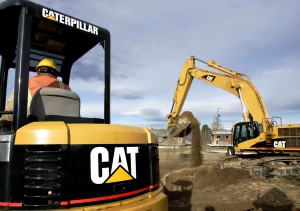Analysts have forecasted Caterpillar, Inc. (CAT), the industry-leading construction equipment manufacturer, to decrease in production this year. The company has been relying in foreign markets such as Asia and in the Pacific to keep them afloat after the 2008 recession. Looking at the decline in spending and cut backs in these foreign markets, analysts are forecasting rough weather in the upcoming quarters for CAT.
One of the biggest hits for Caterpillar was in purchasing Bucyrus International Inc. for $8 billion in 2011. This Chinese mining company was overvalued by $580 million, due to what Caterpillar thinks, were inflated profits by managers. Since China, the world’s largest exporter, has slowed down in production, Caterpillar is suffering as well.
According to the Wall Street Journal, CAT has announced 11% decrease in sales from this past quarter. This slow down, however, was not what Caterpillar had expected. In January, Caterpillar gave an outlook report for 2013 where they forecasted an increase in revenue of $8 billion and a $2 earnings per share increase. On the other hand, analysts are predicting that they will decrease in revenue from $65.2 billion to $62.1 billion by end of 2013.
Halting demand for mining equipment in Australia and Indonesia have also taken a tole in Caterpillar’s forecasting plan. With all markets slowing down, except for in Latin America, Caterpillar’s opportunity will be in these upcoming quarter. Caterpillar and other companies in the same situation will all be keeping their fingers crossed for the US economy to pick up and start new production of construction and mining equipment to get back on track.
Another threat to Caterpillar is the more favorable use of natural gas to produce electricity. This causes a decrease in use of mining equipment and slows down equipment production. The narrowing use of CAT products has forced them to lay off the workers in the assembly plants.
Competitors of Caterpillar, like Komatsu, (the world’s second-largest seller of construction equipment) has also been struggling in the same markets and has already decreased their sales and profit forecast for this upcoming year. If Komatsu seen this coming, why didn’t Caterpillar?
With all these factors coming into play, Caterpillar should be reconsidering their forecasting plan and cut back on production as well as profit expectations for 2013. Will they heed this information or continue with their plan?
Do you think Caterpillar should have planned for this pause in production? Maybe Caterpillar should start producing new equipment for a new kind of consumer.


I feel that Caterpillar had this coming. They bought a company for more than it was worth, which resulted in a loss of earnings per share. The U.S.A. is currently pulling itself out of a recession and with recent switches to natural gases, this type of equipment is not needed. I don’t see a huge demand for these type of products unless they start to innovate and create products that can be used for new technologies.
I definitely think that Caterpillar had the right idea when deciding to target foreign markets such as Asia. The fact of the matter is that economic downturn in both the US and EU are catching up with the global economy and impacting emerging markets. Caterpillar has had a rough past few years and needs to step up the risk management procedures and produce more conservative forecasts. I would be very interested to see if CAT decides to explore new industry opportunities or find ways to evolve its products.
I believe CAT should have planned for the economic slowdown with better forecasting. With the decrease in production in China, CAT should focus their energy on Latin America. Latin America is home to developing nations which they can take advantage of. Aside from Latin America, CAT should create machines that will help improve existing structures for the more developed countries, essentially creating a new product for the same consumers.